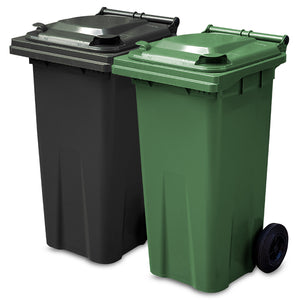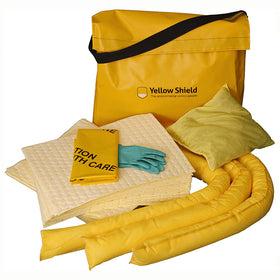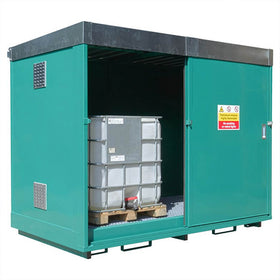10 Top Tips on Best Practice in Using Wheelie Bins for Waste Disposal:
By sticking to a few common sense rules when managing wheelie bins on your premises will aid you in keeping your waste disposal legal, efficient and will allow you to better avoid water, air or soil pollution. Following basic protocols will enable you to determine if your waste is municipal solid waste from everyday consumption or if it requires any special treatment.
1. Decide if your waste is municipal solid waste or of a hazardous nature.
Incorrect disposal of hazardous wastes is illegal and can result in harm to the environment. To make sure that you know what constitutes hazardous waste they are some examples at the end of this blog. If you are in any doubt at all then please use the Environment Agency guideline: What is a Hazardous Waste, as a guide.
2. Wastes from Commercial or Industrial Sites.
If your waste is free of hazardous materials then the Duty of Care (a law which states that you must take responsible action to ensure waste safety) requires any transfer of waste to be affixed with a written description. For example;
“General non-hazardous waste from electrical engineering comprising of food waste, paper, metal, cardboard, plastic packaging and floor sweepings.”
3. Disposing of Used Oil
Engine oils and absorbents sopping with engine oils should be disposed of as a Special Waste or via your Local Oil Bank, some of which are located at supermarkets around the country. Oil Banks are strictly for the disposal of waste engine oils are not cooking oils or any other chemical. For further information see Pollution Prevention Guidelines Safe Storage and Disposal of Used Oils: PPG8.
4. Line your Wheelie Bin
This is a very simple but effective measure for keeping your wheelie bin clean. Wheelie Bin Liners minimise the contamination of the bin and using a biodegradable bin liner reduces the impact on the environment.
5. Contaminated Consumables
Everyday items that become contaminated such as wipes, disposable nappies, or food waste should be secured within biodegradable bags and placed into the bin.
6. Ensure the Lid Remains Closed
If vandalism is a frequent and persistent problem in your area, or if your wheelie bin is regularly filled with food waste, then the bin should be locked. Wheelie bins can be purchased with a fitted lock or they can be retrospectively fitted.
7. WRAP Compliant Recycle Stickers for Wheelie Bins
WRAP (Waste and Resources Action Programme) polypropylene stickers are an efficient way identifying the type of the waste in the bin. The stickers can help ensure compliance with the EU Landfill Directive.
8. Cleaning Wheelie Bins
Wheelie bins used for general waste can become malodorous, attract flies and other insects and generally be unhygienic if not regularly cleaned. These problems can be eradicated by following some basic principles in cleaning your wheelie bins.
Wheelie Bins should be cleaned frequently following guidelines as set out by the Environment Agency.
a. Ensure that the bin is completely empty
Before cleaning remove any lingering waste from the bin and place into a biodegradable bag and seal.
b. Use the required amount of water
Only use the minimum quantity of water when cleaning your bin. 1 litre of water should be sufficient for most standard sized 2 wheeled bins.
c. Use biodegradable detergent or disinfectants.
Biodegradable products are environmentally friendly and will not cause harm to water bodies or the animals within them. Again, only use the required amount.
d. Safely store detergents and disinfectants.
Safe storage will help prevent spillage.
e. Contaminated waste water.
Contaminated waste water should not enter any drainage system. Your local water company will advise of the nearest location for disposal. A licence is required and a charge may levied.
9. Professional Mobile Wheelie Bin Cleaning Services
If you are unable for whatever reason to comply with the above guidelines then professional wheelie bin cleaning services are available. Mobile cleaning vehicles carry a supply of water and recycle the wash water into a foul sewer at an approved site.
10. Drainage Systems
However you clean your wheelie bin you must take extra care not to cause pollution of a watercourse. Road gullies and drains are designed to carry surface water directly to the nearest river or stream, so any contaminated water or non-biodegradable detergent released into them will result in pollution. If convicted, this can carry a maximum penalty of a £50,000 fine or twelve months imprisonment in a Magistrates Court. If convicted in a Crown Court the fine can be unlimited and the offender can be given a custodial sentence of up to five years.
Examples of Hazardous Waste:
Nearly all businesses will produce hazardous waste of some type. Such examples include:
• Asbestos
• Chemicals, e.g. brake fluid and printer toner
• Electrical equipment with potentially harmful components such as cathode ray tubes, e.g. computer monitors and televisions
• Fluorescent light tubes and energy saving light bulbs
• Vehicle and other lead-acid batteries
• Oils (except edible oils) e.g. engine oil
• Refrigerators containing ozone-depleting substances
• Solvents, e.g. aerosols
• Pesticides
www.yellowshield.co.uk



